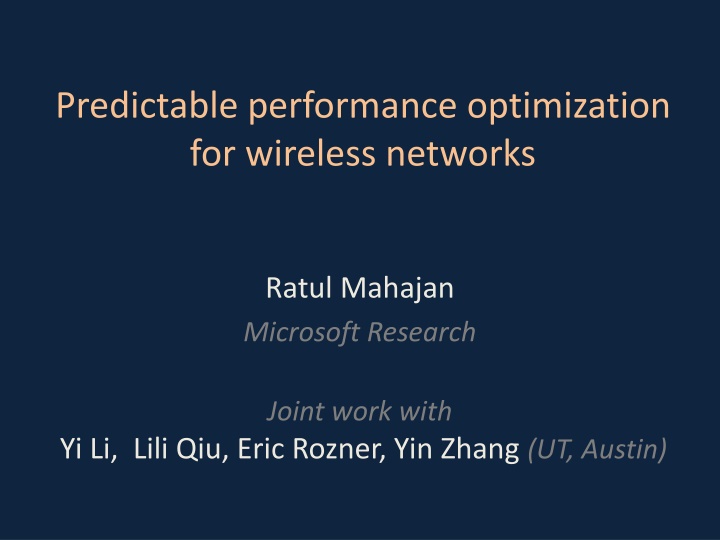
Wireless Network Performance Optimization Strategies
Explore the challenges of unpredictable wireless network performance and the solutions for optimizing performance predictably. Learn about measurement-based modeling, RF profile analysis, and source rate optimization for enhanced network efficiency.
Download Presentation

Please find below an Image/Link to download the presentation.
The content on the website is provided AS IS for your information and personal use only. It may not be sold, licensed, or shared on other websites without obtaining consent from the author. If you encounter any issues during the download, it is possible that the publisher has removed the file from their server.
You are allowed to download the files provided on this website for personal or commercial use, subject to the condition that they are used lawfully. All files are the property of their respective owners.
The content on the website is provided AS IS for your information and personal use only. It may not be sold, licensed, or shared on other websites without obtaining consent from the author.
E N D
Presentation Transcript
Predictable performance optimization for wireless networks Ratul Mahajan Microsoft Research Joint work with Yi Li, Lili Qiu, Eric Rozner, Yin Zhang (UT, Austin)
Wireless performance is unpredictable Even basic questions are hard to answer How much traffic can a given network support? What happens if a new flow starts? What happens if a node is removed? Arguably the most frustrating aspect of wireless Mysteriously inconsistent performance Makes it almost impossible to plan and manage ratul | msr cognitive summit | june '08 2
An example of performance weirdness Bad Good Source Relay Sink Good Bad Source Relay Sink UDP throughput (Kbps) UDP throughput (Kbps) bad-good UDP throughput (Kbps) Simulation Testbed bad-good bad-good good-bad good-bad 2x good-bad Source rate (Kbps) Loss rate on the bad link Loss rate on the bad link ratul | msr cognitive summit | june '08 3
Predictable performance optimization Given a (multi-hop) wireless network: 1. Can its performance for a given traffic pattern be predicted? 2. Can it be systematically optimized per a desired objective such as fairness or throughput? Yes, and Yes, at least in the context of WiFi ratul | msr cognitive summit | june '08 4
Our approach: measurement-based modeling and optimization Measure the RF profile of the network Constraints on sending rate and loss rate of each link Find compliant source rates that meet the objective ratul | msr cognitive summit | june '08 5
Measurements Measure the RF profile of the network One or two nodes broadcast at a time Constraints on sending rate and loss rate of each link Yields information on loss and deferral probabilities Find compliant source rates that meet the objective ratul | msr cognitive summit | june '08 6
Modeling O(n2) constraints 1. Link throughput is a function of loss rate and tx probability 2. Link tx probability is a function of tx probability of other links and deferral probability 3. Link loss rate depends on tx probability of other links 4. Tx probability is bounded by a function of loss rate Measure the RF profile of the network Constraints on sending rate and loss rate of each link Find compliant source rates that meet the objective ratul | msr cognitive summit | june '08 7
Optimization Inputs: Traffic matrix Routing matrix Optimization objective Measure the RF profile of the network Constraints on sending rate and loss rate of each link Output: Per-flow source rate Find compliant source rates that meet the objective ratul | msr cognitive summit | june '08 8
Accuracy of throughput prediction in a testbed 1 0.9 Cumulative fraction of flows No scaling Scale = 10% Scale = 50% 0.8 0.7 0.6 0.5 0.4 0.3 0.2 0.1 0 0 0.2 0.4 0.6 0.8 1 Actual / predicted throughput ratul | msr cognitive summit | june '08 9
Benefit of throughput optimization in a testbed 6 Average total throughput (Mbps) Without optimization 5 With optimization 4 3 2 1 0 1 2 4 8 12 16 Number of flows ratul | msr cognitive summit | june '08 10
Lessons learned Simple measurements on off-the-shelf hardware can provide accurate and tractable RF profile [SIGCOMM2006] Compare with abstract models (e.g., distance) or direct, detailed measurements It is possible to model interference, MAC, and traffic in a way that balances fidelity and tractability [MobiCom2007] The three are inter-dependent Holistically controlling source rates is important for achieving desired outcomes [SIGCOMM2008] Impact of transmissions not limited to the traversed path ratul | msr cognitive summit | june '08 11
More challenges ahead Changing spectrum availability and no fixed transmission channels Newfangled receivers Heterogeneous MACs Multiple competing networks As we move towards a brave new wireless world, performance predictability should be a central goal ratul | msr cognitive summit | june '08 12


